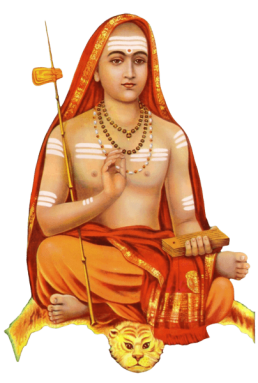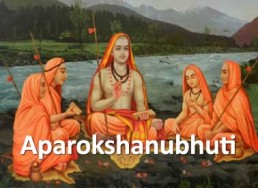Aparokshānubhuti
Direct-Experience of the Absolute or Self-Realization

Aparokshānubhuti
Aparokshanubhuti, or Direct Experience of the Absolute is an introductory work by Adi Shankaracharya that expounds Advaita Vedanta philosophy. Aparoksha refers to the ‘nearest of the near’, one’s Self. Anubhuti means to realize, to experience. So the word means “Self-realization.” Such realization, unlike the knowledge of objects through sense-perception or inference, is an immediate and direct perception of one’s own Self, which is here indicated by the word Aparoksha.
The central theme of the book is the identity between Jivatman (individual Self) and Paramatman (Universal Self)
Introduction by Swami Vimuktananda (1938, Belur Math)
Aparokshānubhuti Verses - In Sanskrit and English with Meaning and Commentary
AA – 1-Sri Aparoksanubhutih
AA – 2-Aparokṣānubhūtirvai
AA – 3-Svavarṇāśramadharmeṇa
AA – 4-Brahmādisthāvarānteṣu
AA – 5-Nityamātmasvarūpaṃ
AA – 6-Sadaiva vāsanātyāgaḥ
AA – 7-Viṣayebhyaḥ
AA – 8-Nigamācāryavākyeṣu
AA – 9-Saṃsāra bandhanirmuktiḥ
AA – 10-Uktasādhanayuktena
AA – 11-Notpadyate
AA – 12-Ko’haṃ kathamidaṃ
AA – 13-Nāhaṃ bhūtagaṇo
AA – 14-Ajñānaprabhavaṃ
AA – 15-Etayoryadupādā namekaṃ
AA – 16-Ahameko’pi
AA – 17-Ātmā viniṣkalo
AA – 18-Ātmā niyāmakaścāntardeho
AA – 19-Ātmā jñānamayaḥ
AA – 20-Ātmā prakāśakaḥ
AA – 21-Ātmā nityo
AA – 22-Ātmanas tatprakāśatvaṃ
AA – 23-Deho’hamityayaṃ
AA – 24-Brahmaivāhaṃ
AA – 25-Nirvikāro
AA – 26-Nirāmayo
AA – 27-Nirguṇo niṣkriyo
AA – 28-Nirmalo niścalo’nantaḥ
AA – 29-Svadehaṃ
AA – 30-Svātmānaṃ
AA – 31-Ahaṃśabdena
AA – 32-Ahaṃ draṣṭṛtayā
AA – 33-Ahaṃ vikārahīnastu
AA – 34-Yasmātparamiti
AA – 35-Sarvaṃ puruṣa
AA – 36-Asaṅgaḥ puruṣaḥ
AA – 37-Tatraiva
AA – 38-Prokto’pi
AA – 39-Liṅgaṃ cānekasaṃyuktaṃ
AA – 40-Evaṃ dehadvayādanya
AA – 41-Ityātmadehabhānena
AA – 42-Ityātmadehabhedena
AA – 43-Caitanya syaikarūpatvādbhedo
AA – 44-Rajjvajñānāt kṣaṇenaiva
AA – 45-Upādānaṃ
AA – 46-Vyāpyavyāpakatā
AA – 47-Śrutyā nivāritaṃ
AA – 48-Doṣo’pi vihitaḥ
AA – 49-Brahmaṇaḥ
AA – 50-Brahmaiva
AA – 51-Suvarṇājjāyamānasya
AA – 52-Svalpamapyantaraṃ
AA – 53-Yatrājñānādbhaved
AA – 54-Yasminsarvāṇi
AA – 55-Ayamātmā
AA – 56-Anubhūto’pyayaṃ
AA – 57-Svapno jāgaraṇe’līkaḥ
AA – 58-Trayamevaṃ
AA – 59-Yadvanmṛdi
AA – 60-Yathā mṛdi
AA – 61-Yathaiva
AA – 62-Yathaiva
AA – 63-Yathā taraṅga
AA – 64-Ghaṭanāmnā
AA – 65-Sarvo’pi
AA – 66-Kāryakāraṇatā
AA – 67-Gṛhyamāṇe
AA – 68-Sadaivātmā
AA – 69-Yathaiva
AA – 70-Sarpatvena
AA – 71-Ghaṭatvena
AA – 72-Kanakaṃ kuṇḍalatvena
AA – 73-Puruṣatvena
AA – 74-Gṛhatvenaiva
AA – 75-Yathā vṛkṣaviparyāso
AA – 76-Potena gacchataḥ
AA – 77-Pītatvaṃ
AA – 78-Cakṣurbhyāṃ
AA – 79-Alātaṃ bhramaṇenaiva
AA – 80-Mahattve
AA – 81-Sūkṣmatve
AA – 82-Kācabhūmau
AA – 83-Yadvadagnau
AA – 84-Abhreṣu satsu
AA – 85-Yathaiva
AA – 86-Yathā śaśī
AA – 87-Evamātmani
AA – 88-Sarvamātmatayā
AA – 89-Ātmānaṃ satataṃ
AA – 90-Utpanne’pyātmavijñāne
AA – 91-Tattvajñānodayā
AA – 92-Karma janmāntarakṛtaṃ
AA – 93-Svapnadeho
AA – 94-Upādānaṃ
AA – 95-Yathā rajjuṃ
AA – 96-Rajjurūpe
AA – 97-Dehasyāpi
AA – 98-Kṣīyante
AA – 99-Ucyate’jñairbalā
AA – 100-Tripañcāṅgānyatho
AA – 101-Nityābhyāsādṛte
AA – 102-Yamo hi niyamastyāgo
AA – 103-Prāṇasaṃyamanaṃ
AA – 104-Sarvaṃ brahmeti
AA – 105-Sajātīyapravāhaśca
AA – 106-Tyāgaḥ prapañcarūpasya
AA – 107-Yato vāco
AA – 108-Vāco yasmānnivartante
AA – 109-Iti vā tadbhavenmaunaṃ
AA – 110-Ādāvante
AA – 111-Kalanātsarva bhūtānāṃ
AA – 112-Sukhenaiva
AA – 113-Siddhaṃ yatsarvabhūtādi
AA – 114-Yanmūlaṃ
AA – 115-Aṅgānāṃ samatāṃ
AA – 116-Dṛṣṭiṃ jñānamayīṃ
AA – 117-Draṣṭṛdarśana dṛśyānāṃ
AA – 118-Cittādisarva bhāveṣu
AA – 119-Niṣedhanaṃ
AA – 120-Tatastadvṛtti naiścalyaṃ
AA – 121-Viṣayeṣvātmatāṃ
AA – 122-Yatra yatra
AA – 123-Brahmaivāsmīti
AA – 124-Nirvikāratayā
AA – 125-Evaṃ cākṛtrimānandaṃ
AA – 126-Tataḥ sādhananirmuktaḥ
AA – 127-Samādhau
AA – 128-Layastamaśca
AA – 129-Bhāvavṛttyā
AA – 130-Ye hi vṛttiṃ
AA – 131-Ye hi vṛttiṃ
AA – 132-Yeṣāṃ vṛttiḥ
AA – 133-Kuśalā brahmavārtāyāṃ
AA – 134-Nimeṣārdhaṃ
AA – 135-Kārye kāraṇatāyātā
AA – 136-Atha śuddhaṃ
AA – 137-Anenaiva
AA – 138-Kāraṇaṃ vyatirekeṇa
AA – 139-Kārye hi kāraṇaṃ
AA – 140-Bhāvitaṃ tīvravegeṇa
AA – 141-Adṛśyaṃ bhāvarūpaṃ
AA – 142-Dṛśyaṃ hyadṛśyatāṃ
AA – 143-Ebhiraṅgaiḥ
AA – 144-Paripakvaṃ
AA – 145-Closing
Introduction to Aparokshanubhuti
Swami Vimuktananda, Belur Math, 1938
Treatises that aim at serving as introductions to a more advanced study of a system of philosophy are generally known as Prakarana Granthas. Besides giving an outline of the system, each of them emphasizes some one or other of the main features. Aparokshanubhuti is one such little manual, which, while presenting a brief description of Vedanta, deals specially with that aspect of it which relates to the realization (Anubhuti) the highest Truth. Such realization, unlike the knowledge of objects through sense-perception or inference, is an immediate and direct perception of one’s own Self, which is here indicated by the word Aparoksha. The central theme of the book is the identity of the Jivâtman (individual self) and Paramâtman (Universal Self). This identity is realized through the removal of the ignorance that hides the truth, by the light of Vichåra or enquiry alone (verse 11). To enable the mind to embark on such an investigation into truth, certain disciplines are laid down, which are not peculiar to Vedanta, but are indispensable for all such enquiries into the highest Truth.
The book then gives a description of one who has attained this realization and of the nature of his life. Then follows a discussion on Prârabdha, the momentum of past actions. The author contends that after realization, when ignorance with all its effects entirely disappears, the question of the survival of the body for working out Prârabdha is altogether out of place; and the Sruti sometimes speaks of it only to explain to the ignorant the apparent behaviour of a man of realization, who, so far as he himself is concerned, is ever immersed in the Supreme Truth.
Verses 100 to 129 deal specially with the fifteen stages through which the seeker after Truth passes which, by the way, are similar to those experienced by a Râja-Yogin; but the two are entirely different. Then is the oneness of cause and effect—the Absolute and the manifested universe-which is wound up with the culminating thought of the Vedanta philosophy that all that is visible and invisible is in reality the one eternal Âtman, which is Pure Consciousness (verse 141).
The authorship of the book is generally attributed to Sri Sankarâchârya. Even if this be disputed, the teachings are undoubtedly Advaitic. To those, therefore, who have neither the time nor the opportunity to go through the classical works of Sankarâchârya, a treatise like the present one will be an invaluable guide in their quest after spiritual truths.
It may be mentioned here that verses 89 to 98 occur with slight variations also in the Nâdabindu Upanishad (21-29) and verses 102 to 136, 140 and 142, in the Tejabindu Upanishad (15-51).


